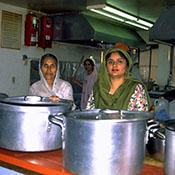 Langar is the communal meal shared by all who come to the gurdwara, and it has been a part of Sikh community since the time of Guru Nanak. Attendees all sit at an equal level on the floor and eat the same food, prepared in the same pots. In this way, langar serves as a ritualistic expression of the equality of all humans.
Langar is the communal meal shared by all who come to the gurdwara, and it has been a part of Sikh community since the time of Guru Nanak. Attendees all sit at an equal level on the floor and eat the same food, prepared in the same pots. In this way, langar serves as a ritualistic expression of the equality of all humans.
View Full Album
In Fremont, California, the family in the kitchen in the large gurdwara is preparing rice, lentils, potato curry, vegetable curry, bread, and pudding for the entire community. In the corner of the large community dining hall a closed-circuit television set enables them to hear the singing and view the crowd in the sanctuary next door. While the Sodhi family began the preparation of the communal meal called langar some hours ago, they signed up months in advance for this particular day. Over the past weekend, the eldest daughter in the family graduated from a local community college. Preparing this meal for the Sikh community is, for the Sodhis, both an honor and a celebration. According to Raj Sodhi, the professor whose family is in charge, they shopped on Friday, peeled and diced potatoes all day Saturday, and today are cooking for some 400 people.
Langar is the communal meal shared by Sikhs and all visitors to the gurdwara. Since the founding of the Sikh community, langar has come to be an important part of Sikh religious life. After the service, no Sikh will leave without partaking of langar. For Sikhs, eating together in this way is expressive of the equality and oneness of all humankind. At the same time, it strengthens the Sikh sense of community. Visitors and guests are readily and warmly included in the great hospitality of the Sikh tradition. In visiting a gurdwara one will always be offered the sweet prashad which is distributed in the sanctuary as the “grace” of the guru. And in visiting at the time of a service, one will be offered the entire langar meal.
One of the most obvious signs of caste inequality in traditional Indian society is the taboo against eating with those outside one’s caste group, of a lower caste, or of a different religion. Rules for the sharing of food and water are many, especially among high caste Hindus. From the beginning, the Sikh gurus explicitly rejected this inequality by asking that all Sikhs and all visitors to the Sikh gurdwaras partake of common food in the company of one another. In the langar hall, women and men, rich and poor, high and low sit together. The langar meal thus assails the inner core of inequality and symbolizes a Sikh’s personal rejection of prejudice.
Preparing langar as the Sodhi family is doing today is an important part of the life of the Sikh community. Men, women, and children all participate, and the service is said to be of great merit. The huge size of the bowls and pots, the mixers and ovens in a large gurdwara like that in Fremont is a challenge for the average family. The full meal they prepare consists of simple Punjabi village fare—all vegetarian, not because Sikhs themselves are necessarily vegetarian but because this is the food most widely shared, especially across religious lines.
When the meal is ready, a small portion of each dish is put in a stainless steel bowl and placed in front of the Guru Granth Sahib. Then the Ardas prayer is recited to seek God’s acceptance of the food. The food is then returned to the original pot so that the blessings of the guru can be passed on to the people through the whole pot of food. When people come into the langar hall, they sit on the floor on long rows of rugs as the servers circulate among them, bringing fresh food and hot bread. There is a serious, but joyful atmosphere as friends, family and visitors enjoy the langar and the company of the community.